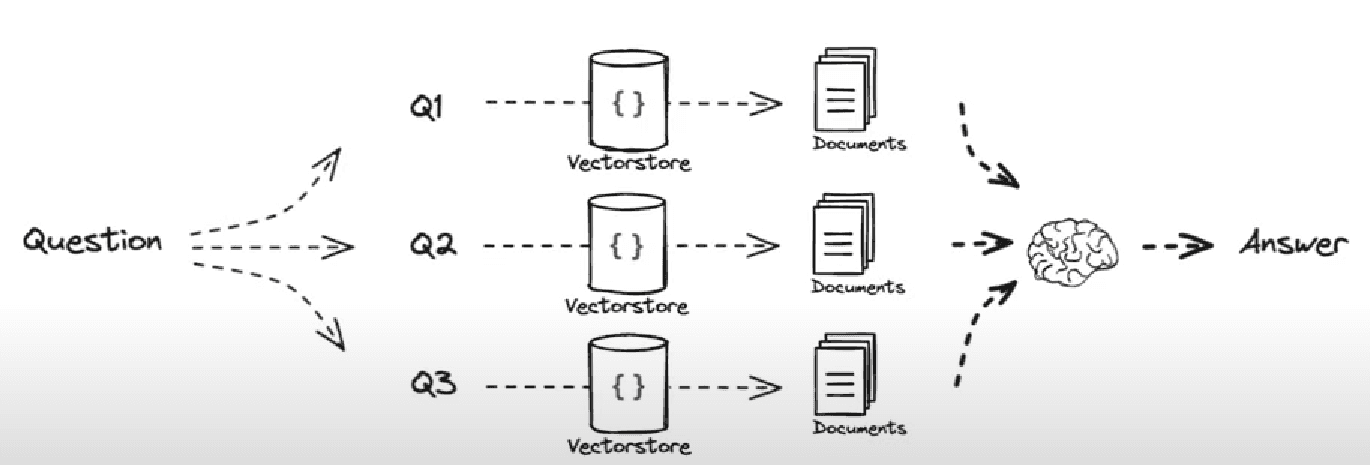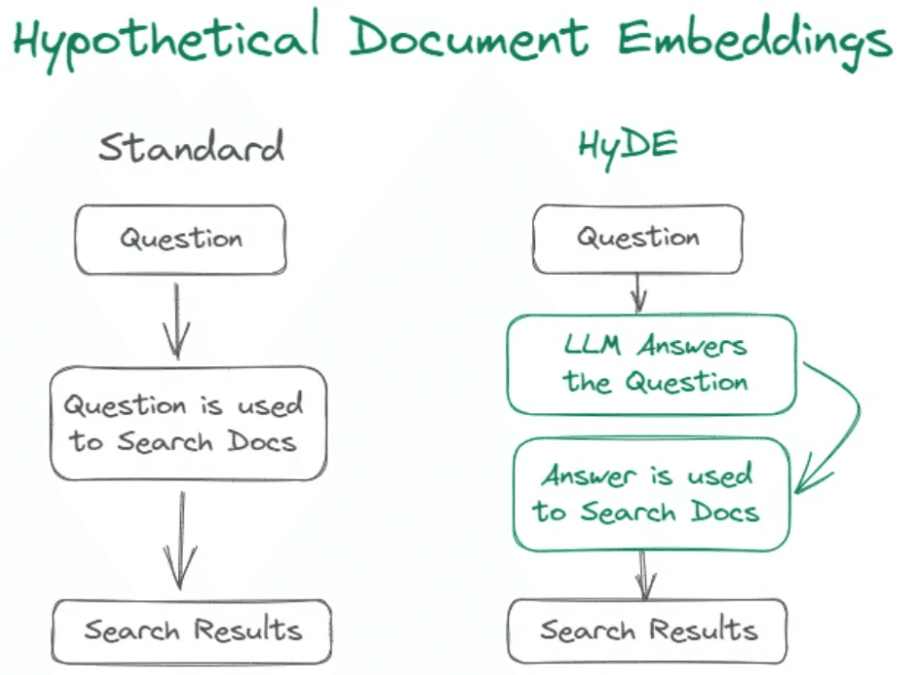HyDE and Seek: Improving RAG with Multiple Queries
Jul 22, 2024
Jul 22, 2024
Jul 22, 2024


Was RAG enough?
While Retrieval-Augmented Generation (RAG) has significantly improved AI's ability to provide accurate and up-to-date information, it still has limitations. RAG often depends heavily on how queries are phrased, and can struggle with nuanced or complex information needs. To address these challenges, advanced methods like HyDE and Multi-Query Retrieval have emerged. These techniques enhance RAG by improving document retrieval and query processing, ensuring more precise, comprehensive, and contextually relevant results. Let's dive into how these innovations can elevate your AI solutions.
The Magic of Multi-Query
At its heart, Multi Query Retrieval generates and explores multiple variations of a single user input. This technique recognizes that one query might not capture all the context or intent behind your question. By broadening the search criteria, AI systems can gather a more relevant and comprehensive set of answers.
Instead of relying on a single set of documents for an initial query, it retrieves multiple sets based on varied interpretations. This is super handy for vague or imprecise questions. Casting a wider net increases the chances of finding the best answers from a sea of information.

The multi-query effect
Multi-query RAG operates by expanding the query space. Unlike traditional RAG models that rely on a single query, this approach generates multiple query variations to capture the breadth of user intent. Each of these queries is transformed into a dense numerical representation, or embedding, which serves as a semantic fingerprint. By comparing these embeddings to a vast corpus of document embeddings, the system can identify a wider range of relevant documents. This enriched pool of information enables the language model to generate more comprehensive, informative, and accurate responses, effectively mitigating the limitations of single-query approaches.
HyDE: A Game-Changer
HyDE uses a Language Learning Model, like ChatGPT, to create a theoretical document when responding to a query, rather than just using the query and its computed vector to search in the vector database. Instead of looking for embedding similarity for questions, it focuses on answer-to-answer embedding similarity, making it robust and effective in tasks like web search, QA, and fact verification.
How HyDE Works
HyDE ensures your searches are efficient and spot-on! It doesn't just look for similar questions and answers but understands the content it generates. This approach makes it effective in tasks like web search, question answering, and fact-checking. HyDE adapts and refines searches on the fly, without needing a massive list of examples.
HyDE generates a hypothetical document based on a user query.
Generated document is encoded into an embedding vector.
Vector is used to find similar real documents in the corpus.

Ride the HyDE
Traditionally, document retrieval in RAG has been based on the similarity between the query and document embeddings. While this method shows promise, it often falls short in capturing nuanced information needs. This is where HyDE steps in. HyDE generates hypothetical document embeddings that represent ideal documents to answer a query, guiding the retrieval process towards more relevant information and improving RAG performance.
Why HyDE is a Game-Changer
HyDE’s innovative technique improves document retrieval by generating hypothetical document embeddings. By leveraging these embeddings, HyDE guides the retrieval process towards documents more likely to contain relevant information. This approach enhances the model’s ability to cross-validate information from different sources, increasing the reliability and trustworthiness of the generated content.
Conclusion
Both HyDE and Multi-Query Retrieval represent significant advancements over traditional RAG methods, addressing its limitations and enhancing its capabilities. HyDE's ability to generate hypothetical document embeddings ensures that the retrieval process is more aligned with the user's query, resulting in more accurate and relevant information. On the other hand, Multi-Query Retrieval broadens the search scope, capturing the full context and intent behind user queries for richer, more comprehensive results.
By incorporating these cutting-edge techniques, you can significantly improve the performance of your AI systems, ensuring they provide precise, reliable, and contextually relevant information. Embrace these advancements to stay ahead in the AI game and transform your business operations with superior, dynamic information retrieval.
Ready to take your AI solutions to the next level? Contact us to explore how HyDE and Multi-Query Retrieval can revolutionize your business.
Sources
RAG from scratch: Part 5 (Query Translation -- Multi Query)
Enhancing RAG performance using Hypothetical Document Embeddings (HyDE)
Advanced RAG: Improving Retrieval-Augmented Generation with Hypothetical Document Embeddings (HyDE)
Was RAG enough?
While Retrieval-Augmented Generation (RAG) has significantly improved AI's ability to provide accurate and up-to-date information, it still has limitations. RAG often depends heavily on how queries are phrased, and can struggle with nuanced or complex information needs. To address these challenges, advanced methods like HyDE and Multi-Query Retrieval have emerged. These techniques enhance RAG by improving document retrieval and query processing, ensuring more precise, comprehensive, and contextually relevant results. Let's dive into how these innovations can elevate your AI solutions.
The Magic of Multi-Query
At its heart, Multi Query Retrieval generates and explores multiple variations of a single user input. This technique recognizes that one query might not capture all the context or intent behind your question. By broadening the search criteria, AI systems can gather a more relevant and comprehensive set of answers.
Instead of relying on a single set of documents for an initial query, it retrieves multiple sets based on varied interpretations. This is super handy for vague or imprecise questions. Casting a wider net increases the chances of finding the best answers from a sea of information.

The multi-query effect
Multi-query RAG operates by expanding the query space. Unlike traditional RAG models that rely on a single query, this approach generates multiple query variations to capture the breadth of user intent. Each of these queries is transformed into a dense numerical representation, or embedding, which serves as a semantic fingerprint. By comparing these embeddings to a vast corpus of document embeddings, the system can identify a wider range of relevant documents. This enriched pool of information enables the language model to generate more comprehensive, informative, and accurate responses, effectively mitigating the limitations of single-query approaches.
HyDE: A Game-Changer
HyDE uses a Language Learning Model, like ChatGPT, to create a theoretical document when responding to a query, rather than just using the query and its computed vector to search in the vector database. Instead of looking for embedding similarity for questions, it focuses on answer-to-answer embedding similarity, making it robust and effective in tasks like web search, QA, and fact verification.
How HyDE Works
HyDE ensures your searches are efficient and spot-on! It doesn't just look for similar questions and answers but understands the content it generates. This approach makes it effective in tasks like web search, question answering, and fact-checking. HyDE adapts and refines searches on the fly, without needing a massive list of examples.
HyDE generates a hypothetical document based on a user query.
Generated document is encoded into an embedding vector.
Vector is used to find similar real documents in the corpus.

Ride the HyDE
Traditionally, document retrieval in RAG has been based on the similarity between the query and document embeddings. While this method shows promise, it often falls short in capturing nuanced information needs. This is where HyDE steps in. HyDE generates hypothetical document embeddings that represent ideal documents to answer a query, guiding the retrieval process towards more relevant information and improving RAG performance.
Why HyDE is a Game-Changer
HyDE’s innovative technique improves document retrieval by generating hypothetical document embeddings. By leveraging these embeddings, HyDE guides the retrieval process towards documents more likely to contain relevant information. This approach enhances the model’s ability to cross-validate information from different sources, increasing the reliability and trustworthiness of the generated content.
Conclusion
Both HyDE and Multi-Query Retrieval represent significant advancements over traditional RAG methods, addressing its limitations and enhancing its capabilities. HyDE's ability to generate hypothetical document embeddings ensures that the retrieval process is more aligned with the user's query, resulting in more accurate and relevant information. On the other hand, Multi-Query Retrieval broadens the search scope, capturing the full context and intent behind user queries for richer, more comprehensive results.
By incorporating these cutting-edge techniques, you can significantly improve the performance of your AI systems, ensuring they provide precise, reliable, and contextually relevant information. Embrace these advancements to stay ahead in the AI game and transform your business operations with superior, dynamic information retrieval.
Ready to take your AI solutions to the next level? Contact us to explore how HyDE and Multi-Query Retrieval can revolutionize your business.
Sources
RAG from scratch: Part 5 (Query Translation -- Multi Query)
Enhancing RAG performance using Hypothetical Document Embeddings (HyDE)
Advanced RAG: Improving Retrieval-Augmented Generation with Hypothetical Document Embeddings (HyDE)